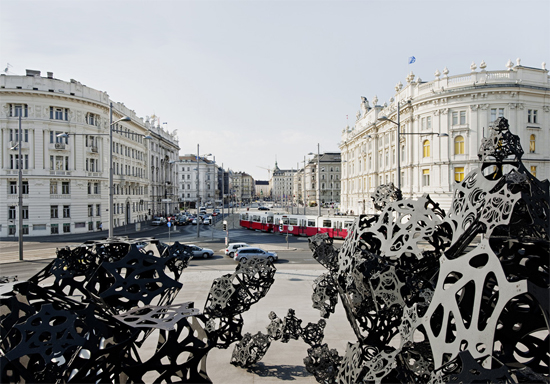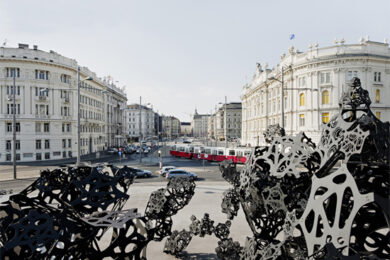Dark and beautiful and vaguely menacing, it crouches on the pavement like a stealth spaceship from an alternative steampunk universe. The ornate wrought-iron skin speaks of some long-lost Jules Verne past, while the armour-plated insectile skeleton hints at big trouble in some future intergalactic warzone, an Art Deco imperial destroyer poised to strike back against the rebel alliance.
This is The Morning Line, a temporary outdoor sculpture and the latest addition to Vienna’s world-class gallery of public art for art’s sake. Twenty tons of aluminium, bigger than a bus, all twisted into biomechanical blooms of charcoal black. From a distance it seems to erupt rudely from its stately plaza setting on the edge of the city centre, bristling with alien menace. But step inside its exploded architecture and these fractal folds feel much more welcoming, soothing you with a round-the-clock piped soundtrack by a gallery of heavyweight post-rock luminaries including Lee Ranaldo, Christian Fennesz, Bruce Gilbert and Sigur Ros frontman Jonsi. Antique and futuristic, audio and visual, avant-garde and accessible: a very Viennese mix. Silence please – the city is singing.
Always a hothouse of experimental noise, Vienna is alive with the sound of music today. Melody and rhythm spill from every ornate corner of this boutique-sized city, which boasts more lavish concert halls and grand theatres than any other European capital. The Hollywood-style stars on the sidewalk commemorate musical icons like Liszt, Mahler and Kurt Weill. Stroll past the palatial opera house and you hear Wagner’s Ring cycle pumped out live via a massive outdoor screen. Glastonbury meets Glyndebourne. Even the toilets in the nearby subway station blast Verdi and Puccini at you.
Music is deeply woven into the Austrian capital’s fabric, even deeper than its centuries-deep pantheon of classical composers, an embarrassment of riches from old masters like Mozart and Strauss to avant-garde modernists like Schoenberg and Webern. At the elegant Haus Der Musik museum in the city centre, you can compose your own Viennese waltz, immerse yourself in a “polyphonium” of sounds, or witness pop-up performances ranging from church choirs to laptop folktronica. But who needs museums when the entire city itself feels like a giant musical instrument, from the percussive crunch of golden leaves underfoot to the rhythmic churn of the river Danube. Crunch. Hiss. Squelch. Thrummmm.
Vienna’s rhythm section is a magnificent fleet of trams that waltz around the inner city’s circular perimeter. The older models, heavy and iron, clank and grind as the cables powering them crackle and fizz overhead. Their newer cousins, sleeker and lighter, glide between stops with a more mellifluous metallic drone. Analogue and digital, each engaged in a stately electro-mechanical dance, encircling the city in a real ring cycle. Inside, a disembodied voice announces each halt in a mechanised Mysterons growl, as serenely sinister as a vintage Kraftwerk album. Clunk. Whirr. Kling klang.
Wandering through these history-haunted streets you might hear the ghostly zither melodies of Anton Karas as Orson Welles looms from the shadows in The Third Man, or the poisonous orchestral duelling of Salieri and Mozart in Amadeus. But you are more likely to encounter the kind of jumbled, scrambled, indie-classical patchwork of sounds that greeted Ethan Hawke and Julie Delpy during their one-night romance in Before Sunrise. The past is never entirely past in Vienna, it just finds harmonious new context alongside newer sounds and cinematic images. Ancient and modern, analogue and digital combined.
Vienna is an endless city-symphony, a monumental mixtape, a vast clockwork music box – but also the location for one of the most refined and absorbing film festivals in the European season. Bathed in crisp autumn sunshine, this year’s Viennale is awash with music, including documentaries on the subversive calypso sweetness of Harry Belafonte, the deceptively wholesome harmonies of Nilsson, and the avant-rock genderfuck of Genesis P-Orridge.
The Viennale programme also features the wallop and clang of Hit So Hard, Peter David Ebersole’s portrait of former Hole drummer and lesbian rock icon Patty Schemel, who was spat out from Courtney Love’s inner circle to become a homeless junkie and occasional prostitute. Ebersole’s film is a fairly conventional affair, complete with redemptive happy ending, but the archive home-movie footage of Schemel with Kurt and Courtney strikes an electrifying power-chord of lost innocence and wasted promise.
Meanwhile, gnarly thrash guitars and metal-bashing car crashes provide the abrasive soundtrack to the dark contemporary LA comedy Hesher, about a grief-stricken schoolboy and his volatile friendship with a heavy rock-loving drifter who moves into his family home uninvited. Joseph Gordon-Levitt plays the mysterious, fitfully violent, morally ambivalent anti-hero in director Spencer Susser’s unlikely marriage of Beavis and Butt-Head with Pasolini’s Theorem. Co-stars Natalie Portman and Devin Brochu also crank it up to 11.
Balkan blues is the musical heartbeat pulsing through Ivan and Ivana, a decade-spanning documentary about a young Bosnian couple who flee war-shattered Kosovo to chase the elusive American Dream in Southern California. Bookended by the bluesy guitar playing of its eponymous leading man Ivan, a charismatic livewire who could have stepped straight out of a classic French New Wave movie, the film takes a bizarre metatextual twist when director Jeff Silva sets his camera down in order to snort heroin with his self-destructive subject.
Ambient audio-visual sound paintings are another motif of this year’s Viennale, with an abundance of monochrome, minimalist, near-wordless films scattered through the programme. Even the bespoke one-minute David Lynch short specially commissioned for the festival, The Three Rs, is a shotgun blast of nightmarish black-and-white abstraction punctuated with sinister clanks and shudders.
At the accessible mainstream end of this epic monochrome symphony is The Artist, a superbly composed retro-homage to Hollywood’s silent-movie heyday from the French writer-director Michel Hazanavicius. It contains just three or four spoken words, some well-placed sound effects and lashings of meticulously synchronised orchestral score. Shot on a much more micro-budget scale, but similarly drained of colour or dialogue, is the experimental documentary Two Years At Sea by the young British director Ben Rivers. Punctuated by musical fragments, this impressionistic portrait of an ageing eccentric living alone in a remote Scottish cottage occupies a fascinating narrative no man’s land between fact and fiction, maddeningly opaque yet oddly mesmerising.
Classic monochrome is also strongly favoured by the first-time American indie directors passing through Vienna. Home-cooked college-town alt-rock provides the soundtrack to post-mumblecore features like Zach Weintraub’s Bummer Summer and Alex Ross Perry’s The Color Wheel, both terrific lo-fi comedies whose young writer-directors also co-star as dysfunctional siblings on ill-fated road trips. Weintraub’s film is beautifully framed in incongruously painterly cinematography, but Perry’s scruffier production pushes more buttons with its relentlessly caustic wit and queasy, unsettling final twist. Both films share the zoned-out deadpan spirit of early Jim Jarmusch circa Stranger Than Paradise and Down By Law.
Another Viennale entry with more music than dialogue is The Silent House, a Uruguayan horror movie almost entirely reliant on sound design for its scare factor. Gustavo Hernandez’s nightmarish yarn was apparently shot in a single take – so murky is the action it is hard to tell for sure. Allegedly inspired by real events, it stars Florencia Corucci as a young woman left alone in a crumbling farmhouse full of malevolent forces that go bump in the night. Very loudly. The basic ingredients may sound clichéd, but the real-time format and hand-held camera lend a nerve-jangling, in-your-face intensity that recalls The Blair Witch Project. Predictably, a Hollywood remake of this classy little shocker is already on the cards.
By day the Austrian capital is an audio-visual banquet of glistening spires and golden domes, imperial palaces and opulent squares. But with the fall of night, this city’s bathed in light. Mostly from the gloriously retro neon signs that grace Vienna’s inner labyrinth of cobbled alleyways, and from the shimmering chandeliers that bring out the warm, wood-lined earth-tones of its sumptuous Art Deco cafes.
But even after the Viennale screenings end, the beat goes on at the Badeschiff, a converted barge moored on an offshoot of the Danube which serves as the festival’s main late-night social hub. Here you will hear film-makers manning the turntables in between free live shows from electronic sound mangler Max Tundra, winsome alt-folkie Laura Gibson, bass-shuddering dubstep pioneer DJ Pinch and more. Strumming and thumping, waltzing and whirring, this cinematic city-symphony never sleeps. Softly, loudly, endlessly – Vienna plays itself.



